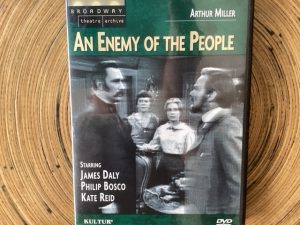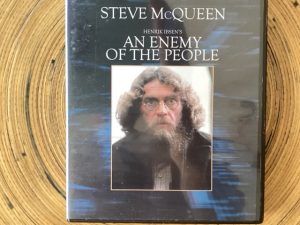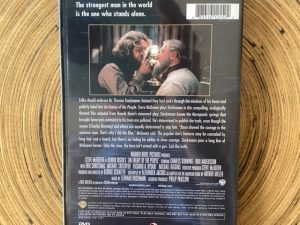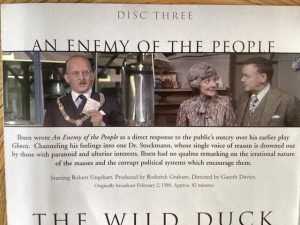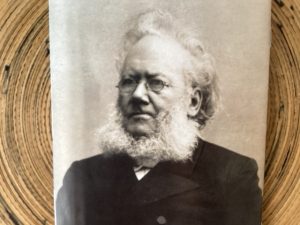(A play adaptation by Arthur Miller I used to teach grade 12s back in 1972-78. Ibsen’s play contained many teachable conflicts and themes. I used to cast members of the class to read aloud the play and make it come to life for them.)
Yesterday I revisited this classic–one of Ibsen’s best–when I watched the 1966 Broadway black-and-white tv version on DVD. It was very much like watching a stage play (directed by Paul Bogart) seamlessly filmed live–not clunky as are some of these old tv drama productions.
Plot-wise, Dr. Stockman is a respected member of a seaside Norwegian town which prides itself on its supposedly therapeutic medical springs that bring in summer tourist trade. However, Stockman is exploring recent cases of visitor sickness and has sent water samples to be analyzed, which reveal the springs are poisoned. He presents this fact to the community, assuming the town council will close the facility to make the necessary repairs. He and the town newspaper writers assume that the truth needs to be told and that Stockman will ultimately be lionized for saving the town.
But reality turns out differently. Instead, he becomes a pariah–“an enemy of the people”–after a community town hall meeting is turned against him by his brother the mayor, the newspaper people he initially entrusted with his information, and muck-raising locals who try to run him and his family out of town.
The many powerful play conflicts include the individual vs. society, authority vs. rebellion, conformity vs. non-conformity, truth vs. lies/illusion/propaganda, medical science vs. chamber of commerce, and free press vs. censorship. The conflicts are all political, intense, and exacerbated by assumptions, agendas, bias, and discrimination. (Much like those conflicts currently raging in and polarizing Canada and the U.S. Politics and politicizing are, similarly, the archetypal snakes in the grass here.)
A range of realistic human behaviors are on display, most of them very ignoble and flawed. Only Dr. Stockman sticks to his guns and holds fast to facts, the truth, and empirical evidence in the face of the howling mob that wants to silence and destroy him. And typical of Ibsen’s style, there are innumerable non-stop, true-to-life ironies that make all this messiness and chaos believable and relevant for the viewer.
Much like our current times, honest, decent, principled people are under fire while the ignorant and corrupt go crazy. Trolling and social ostracism are weapons wielded by the irrational mob and corrupt leaders. Trump has even ignorantly pirated the play’s title to use against the news media today–an echo of Ibsen’s criticism of the media in its failure to tell the truth within the play.
There are uniformly strong performances by all the actors of this production, notably by James Daly as the doctor, Philip Bosco as his corrupt sibling, and Canadian veteran Kate Reid as Catherine, Stockman’s wife.
Overall, An Enemy of the People captures the irrational nature of the masses and the corrupt political systems that encourage them. It remains a rich, relevant play for people looking for significant insights and literary wisdom about our truly troubled times.
…………………………………………….
One other interesting version of this play include Steve McQueen’s 1977 labor-of-love color production filmed as his health was declining. McQueen plays Stockman, Charles Durning plays his brother, and Bibi Andersson plays Mrs. Stockman. Veteran tv director George Schaeffer directs. This production also follows the Arthur Miller adaptation/translation.
Yet another color version uses actual, realistic town and house interiors and exteriors in the 1980 U.K. tv production directed by Gareth Davies. This version has a more modern feel, and will satisfy modern tv viewer expectations. Unlike the other two versions, this one plays and looks more like a film than a filmed stage play. (Part of the BBC Henrik Ibsen Collection DVD set.)
(Henrik Ibsen, ‘the Norwegian Shakespeare’, 1828-1906, author of other popular classics including A Doll’s House, Ghosts, The Wild Duck, The Master Builder, Hedda Gabler, The Lady from the Sea, Peer Gynt, Brand, Pillars of Society, Rosmersholm, Little Eyolf, John Gabriel Borkman, and When We Dead Awaken.

